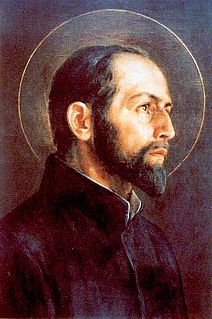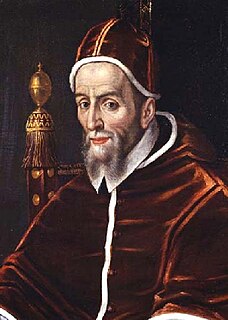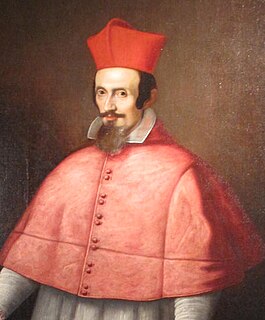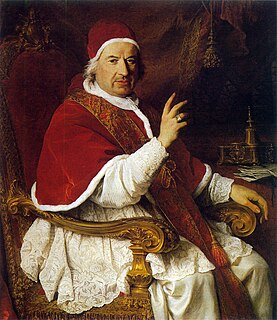Related Research Articles

Pope Alexander VIII, born Pietro Vito Ottoboni, was Pope from 6 October 1689 to his death in 1691. He is to date the last pope to take the pontifical name of "Alexander" upon his election to the papacy.

Anthony Maria Zaccaria, also known as Saint Anthony Zaccaria, was an early leader of the Counter Reformation, the founder of religious orders (Barnabites) and a promoter of the devotion to the Passion of Christ, the Eucharist and the renewal of the religious life among the lay people. His feast day is celebrated on 5 July.

Val Camonica is one of the largest valleys of the central Alps, in eastern Lombardy, Italy. It extends about 90 kilometres (56 mi) from the Tonale Pass to Corna Trentapassi, in the commune of Pisogne near Lake Iseo. It has an area of about 1,335 km2 (515 sq mi) and 118,323 inhabitants.

Pietro Ottoboni was an Italian cardinal and grandnephew of Pope Alexander VIII, who was also born Pietro Ottoboni. He is remembered especially as a great patron of music and art. Ottoboni was the last person to hold the curial office of Cardinal-nephew, which was abolished by Alexander's successor, Pope Innocent XII, in 1692. Ottoboni '"loved pomp, prodigality, and sensual pleasure, but was in the same time kind, ready to serve and charitable".
A doctor of both laws, from the Latin doctor utriusque juris, or juris utriusque doctor, or doctor juris utriusque is a scholar who has acquired a doctorate in both civil and church law. The degree was common among Roman Catholic and German scholars of the Middle Ages and early modern times. Today the degree is awarded by the Pontifical Lateran University after a period of six years of study, by the University of Würzburg, and by the University of Fribourg.

The Roman Diocese Catholic of Brescia is a Latin rite suffragan diocese in the ecclesiastical province of the Metropolitan Archdiocese of Milan, in Lombardy.

Santa Maria in Campitelli or Santa Maria in Portico is a church dedicated to the Virgin Mary on the narrow Piazza di Campitelli in Rione Sant'Angelo, Rome, Italy.

The Diocese of Novara is a Roman Catholic diocese in the Piedmont region of northwest Italy. It is a suffragan of the Archdiocese of Vercelli.

The Roman Catholic Diocese of Padua is an episcopal see of the Catholic Church in Veneto, northern Italy. It was erected in the 3rd century. The diocese of Padua was originally a suffragan (subordinate) of the Patriarchate of Aquileia. When the Patriarchate was suppressed permanently in 1752, it became a suffragan of the Archdiocese of Udine. In 1818, when the dioceses of northern Italy were reorganized by Pope Pius VII, it became a suffragan of the Patriarchate of Venice, and remains so today.
Carlo Bacchiocco was an Italian painter, born in Milan. The volume Scelte Pitture di Brescia by Averoldo mentions several of his pictures in Brescia, particularly in the church of SS. Giacomo e Filippo and Santa Maria degl'Angeli.

The Val Camonica witch trials were two large witch trials which took place in Val Camonica in Italy, in 1505–1510 and 1518–1521. They were among the biggest Italian witch trials, and caused the deaths of about 60 persons, in each trial: 110 in total.

The September 1590 papal conclave elected Giovanni Battista Castagna as Pope Urban VII.

Cesare Monti was an Italian Cardinal who served as Latin Patriarch of Antioch and Archbishop of Milan.

The 1740 papal conclave, convoked after the death of Pope Clement XII on 6 February 1740, was one of the longest conclaves since the 13th century.
Quirino Colombani was an Italian composer, and cellist. He was active in both 17th and 18th centuries.

Filippo Maria Visconti (1721–1801) was the Archbishop of Milan from 1784 to 1801.
The Oratorio di San Carlo is a Baroque-style prayer hall located inside the church of San Carlo al Porto, located on Strada Porto Naviglio in Bologna, region of Emilia-Romagna, Italy.
Ranuccio Scotti Douglas or Ranuzio Scotti Douglas was a Roman Catholic prelate who served as Bishop of Borgo San Donnino (1627–1650), Apostolic Nuncio to Switzerland (1630-1639), and Apostolic Nuncio to France (1639–1641).

Jacopo Antonio Morigia oalso known as Giacomo Antonio Moriggia was a cardinal and Italian Catholic archbishop.

The Standard of Our Lady of Mercy is a 1520-1522 oil on canvas painting by Moretto da Brescia, now in the Tempio Canoviano in Possagno. It is made up of two canvases, now separated one showing Our Lady of Mercy and the other shows The Prophets Enoch and Elijah.
References
- 1 2 Sluhovsky, Moshe. Believe Not Every Spirit: Possession, Mysticism, & Discernment in Early Modern Catholicism. Page 115. University of Chicago Press, 2007.
- 1 2 3 4 5 6 Dooley, Brendan (ed.) Italy in the Baroque: Selected Readings. Pages 572-575. Garland Publishing, Inc., 1995.
- 1 2 3 4 5 6 7 Lea, Henry Charles. A History of the Inquisition of Spain, Vol. IV. Pages 46-48. The MacMillan Company, 1922.